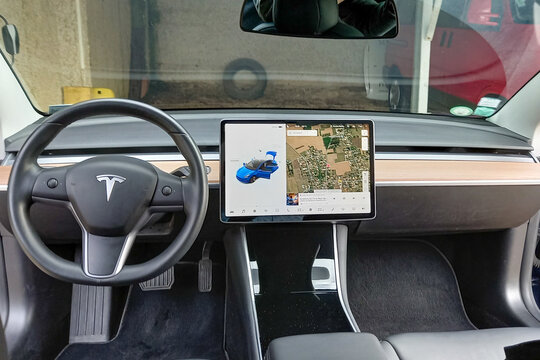In the ever-evolving landscape of urban mobility, AI-driven autonomous electric vehicles (EVs) are not just a futuristic concept; they are rapidly becoming a transformative reality. According to a report by Bloomberg Green, the global market for autonomous vehicles is expected to reach a staggering $556 billion by 2026. This surge is fueled by advancements in AI technology and the increasing demand for sustainable urban transport solutions. In this article, we will explore how these cutting-edge vehicles are redefining urban transportation, offering a glimpse into a future where AI, EVs, and autonomous technology seamlessly converge.
The Rise of AI-Driven Autonomous EVs
AI and Electric Vehicles: A Powerful Synergy
AI’s integration into electric vehicles has unlocked new potentials, making them smarter and more efficient. Companies like Tesla and Rivian are at the forefront of this innovation, utilizing AI to enhance vehicle performance and driver safety.
- Real-time Data Processing: Autonomous EVs use AI to process vast amounts of data from sensors and cameras, allowing for real-time decision-making. This capability not only enhances safety but also optimizes route planning and energy consumption.
- Machine Learning Algorithms: These algorithms enable vehicles to learn from their environment and improve over time, adapting to different traffic patterns and weather conditions.
Impact on Urban Mobility
AI-driven autonomous EVs are poised to revolutionize urban transportation in several ways:
- Reduction in Traffic Congestion: Autonomous vehicles can communicate with each other to optimize traffic flow, reducing congestion and improving commute times.
- Enhanced Safety: With AI’s ability to predict and react to potential hazards, the likelihood of accidents can be significantly reduced.
- Environmental Benefits: By promoting the use of electric vehicles, cities can reduce their carbon footprint, contributing to cleaner air and a healthier environment.
Case Studies: Leading the Charge
Tesla’s Full Self-Driving (FSD)
Tesla’s FSD technology is a testament to how far autonomous EVs have come. As of 2023, Tesla vehicles equipped with FSD can navigate complex urban environments with minimal human intervention. This innovation underscores Tesla’s commitment to making autonomous driving a mainstream reality.
Volkswagen’s ID.Buzz
Volkswagen’s ID.Buzz, a modern take on their classic microbus, is set to feature autonomous capabilities by 2025. This vehicle represents Volkswagen’s vision for sustainable and intelligent urban transport, blending nostalgia with cutting-edge technology.
Overcoming Challenges and Ensuring Safety
Addressing Technological Hurdles
Despite the promising advancements, several challenges remain:
- Regulatory Barriers: Different countries have varied regulations regarding autonomous vehicles, which can slow down their deployment.
- Public Perception: Building public trust in autonomous technology is crucial for widespread adoption. Transparency about safety measures and real-world testing outcomes can aid in overcoming skepticism.
Ensuring Cybersecurity
As vehicles become more connected, cybersecurity becomes paramount. Manufacturers are prioritizing robust security protocols to protect against potential threats, ensuring that autonomous EVs remain safe and reliable.
Practical Guide: Navigating the Autonomous EV Landscape
How to Charge Autonomous EVs
Charging an autonomous EV is similar to charging a conventional EV, but with some added conveniences:
- Public Charging Stations: Use apps like PlugShare to find nearby charging stations compatible with your vehicle.
- Home Charging Solutions: Consider installing a Level 2 home charger for faster charging times.
Where to Buy and What to Compare
When considering an autonomous EV, compare models from leading brands such as Tesla, BYD, and Hyundai. Pay attention to factors like:
- Range and Battery Life: Ensure the vehicle meets your daily commuting needs.
- Autonomous Features: Evaluate the level of autonomy offered and how it aligns with your comfort level.
- Price and Incentives: Look for government incentives that can offset the cost of purchasing an EV.
The Future of Urban Transportation
The integration of AI-driven autonomous EVs into urban transportation systems is not just a trend; it’s a paradigm shift. As these vehicles become more prevalent, they will redefine how we navigate our cities, offering cleaner, safer, and more efficient transport solutions.
Key Takeaways
- Transformative Technology: AI and autonomous capabilities are revolutionizing the EV landscape.
- Urban Impact: Expect reduced traffic congestion, enhanced safety, and environmental benefits.
- Consumer Guide: Know what to consider when purchasing an autonomous EV.
Call to Action
As we stand on the brink of this transportation revolution, what excites you most about the future of autonomous EVs? Share your thoughts and join the conversation about how these innovations will shape our cities.
Looking Ahead
With continuous advancements in AI and battery technology, the future looks bright for autonomous EVs. As cities around the globe embrace these innovations, we can anticipate a smarter, more sustainable urban transport network that meets the demands of tomorrow.
In conclusion, AI-driven autonomous EVs are not just a glimpse into the future; they are paving the way for a new era of urban mobility. By staying informed and engaged, we can all play a part in this exciting evolution.

